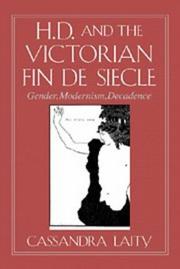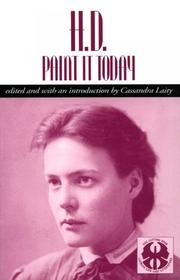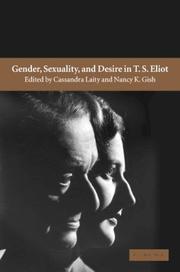| Listing 1 - 3 of 3 |
Sort by
|

ISBN: 0511585659 0511003862 9780511003868 9780521554145 0521554144 0521554144 9780511585654 9780521107891 052110789X Year: 1996 Volume: 104 Publisher: Cambridge : Cambridge University Press,
Abstract | Keywords | Export | Availability | Bookmark
 Loading...
Loading...Choose an application
- Reference Manager
- EndNote
- RefWorks (Direct export to RefWorks)
H. D and the Victorian Fin de Siecle argues foremost that H. D. eluded the male modernist flight from Romantic 'effeminacy' and 'personality' by embracing the very cults of personality in the Decadent Romanticism of Oscar Wilde, A. C. Swinburne, Walter Pater and D. G. Rossetti that her male contemporaries most deplored: the cult of the demonic femme fatale and of the 'effeminate' Aesthete androgyne. H. D., Laity maintains, used these sexually aggressive masks to shape a female modernism that freely engaged female and male androgyny, homoeroticism, narcissism and maternal eroticism. Focusing on the early Sea Garden, the plays and poetry of the 1920s and her late epic Trilogy, H. D. and the Victorian Fin de Siecle demonstrates H. D.'s shift from the homoerotic 'white', vanishing tropology of the male androgyne fashioned by Pater and Wilde to the 'abject' monstrously sexual body of the Pre-Raphaelite and Decadent femme fatale.
Women and literature --- English literature --- Decadence (Literary movement) --- Modernism (Literature) --- American poetry --- Sex (Psychology) in literature. --- Gender identity in literature. --- Aestheticism (Literature) --- Literary movements --- Literature, Modern --- History --- History and criticism. --- English influences. --- History and criticism --- H. D. --- Helforth, John, --- Doolittle, Hilda, --- D., H. --- HD --- Alton, Delia, --- Knowledge --- Literature. --- Arts and Humanities --- Literature

ISBN: 0814734871 Year: 1992 Publisher: New York, N.Y. New York University Press
Abstract | Keywords | Export | Availability | Bookmark
 Loading...
Loading...Choose an application
- Reference Manager
- EndNote
- RefWorks (Direct export to RefWorks)

ISBN: 9780511485091 9780521806886 9780521039468 0511230435 9780511230431 0511231202 9780511231209 0511228805 9780511228803 051122964X 9780511229640 0511485093 0521806887 1280702907 9781280702907 0521806887 0511227108 0511327358 0521039460 Year: 2004 Publisher: New York : Cambridge University Press,
Abstract | Keywords | Export | Availability | Bookmark
 Loading...
Loading...Choose an application
- Reference Manager
- EndNote
- RefWorks (Direct export to RefWorks)
This collection of essays brings together scholars from a wide range of critical approaches to study T. S. Eliot's engagement with desire, homoeroticism and early twentieth-century feminism in his poetry, prose and drama. Ranging from historical and formalist literary criticism to psychological and psychoanalytic theory and cultural studies, Gender, Desire and Sexuality in T. S. Eliot illuminates such topics as the influence of Eliot's mother - a poet and social reformer - on his art; the aesthetic function of physical desire; the dynamic of homosexuality in his poetry and prose; and his identification with passive or 'feminine' desire in his poetry and drama. The book also charts his reception by female critics from the early twentieth century to the present. This book should be essential reading for students of Eliot and Modernism, as well as queer theory and gender studies.
Homosexuality and literature --- Feminism and literature --- Erotic poetry, American --- Sexual orientation in literature. --- Gender identity in literature. --- Human body in literature. --- Desire in literature. --- Sex in literature. --- Body, Human, in literature --- Human figure in literature --- American erotic poetry --- American poetry --- Literature and homosexuality --- Literature --- History --- History and criticism. --- Eliot, T. S. --- Eliot, Thomas Stearns --- Criticism and interpretation. --- Ai-lüeh-tʻe, --- Īliyūt, T. S., --- Elliŏtʻŭ, --- Eliot, Thōmas S., --- Eliot, Th. S., --- Eliot, Thomas Stern, --- Elyoṭ, T. S., --- Ėliot, Tomas Stirns, --- אליוט ט.ס --- אליוט, ת. ס. --- Arts and Humanities
| Listing 1 - 3 of 3 |
Sort by
|

 Search
Search Feedback
Feedback About UniCat
About UniCat  Help
Help News
News